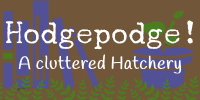Colors
Let's start with the fundamentals of Color, and work up from there. There are three main values that computers use to determine color:
-
Hue: this is, well, the "color" of color. Hue values can be seen as a circle that shifts across the entire rainbow across it's perimeter. Hue values ranges are degrees, 0 to 360, which determine which color is shown. 0 is a red, 60 is a yellow, etc.
-
Saturation: The intensity of the hue. Higher saturation values will show the hue "brighter", more vibrant. Lower saturation values cause the hue to become muted, or greyed out.
-
Luminosity: Also called lightness, brightness, or value. This affects how light or dark the color is. With a saturation of 0, meaning no hue is visible, 100% brightness is pure white, and 0% is pure black.
Colors can be split into four categories, based on how saturation and luminosity work together to affect any hue.
low luminosity + low saturation= muted colors
high luminosity + low saturation= pastel colors
low luminosity + high saturation= rich colors
high luminosity + high saturation= neon colors
We won't get into color theory here, as there are plenty of guides both on and off site for that. All I'll say on it is to use neon colors sparingly. They cause a lot of eyestrain, even in small amounts. If you use a lot of neon colors, consider lowering either luminosity or saturation a bit, in order to ease this strain while still keeping the intent and feel of the bright colors.
When choosing colors, the website
Coolors is very useful. It allows you to create, save, and share color schemes, and it'll even generate complimentary colors for you if you need some help. I highly recommend it!
Contrast:
Contrast is one of the most important parts of making sure your graphics not only look nice, but are accessible to all. Color contrast is how much two colors stand out and are distinct from each other. The higher contrast your text and graphics are, the easier they will be to read and understand. This takes all aspect of a color into account- not just luminosity, but hue and saturation as well.
Every color can be compared against another color to get a ratio that represents the contrast between them. In order to be in compliance with the WCAG, you'll want ratios equal or greater to the following:
3:1 for large text such as titles and headings
4.5:1 for all other text
The math behind getting these ratios is complicated, but luckily there are programs that can do this math for us!
Coolors has a great feature that allows you to compare two colors and see the contrast ratio, as well as gives you a score based on how well the colors contrast and even provides a preview of what these colors look like together.
Colorblind accessibility:
While colors are an important part of any thread design, it's important to keep in mind not everyone can see them. You'll want to make sure that your graphics are understandable to colorblind people as well. Coolors has a feature for this, but it isn't very robust. Instead, I'd like to point you towards Coblis, or Color Blindness Simulator. This program was made by people with colorblindness, and it allows you to view any image through filters that approximate what people with various colorblind conditions see. Use this to check your color schemes; you want to make sure there's a high amount of contrast under all of them.











